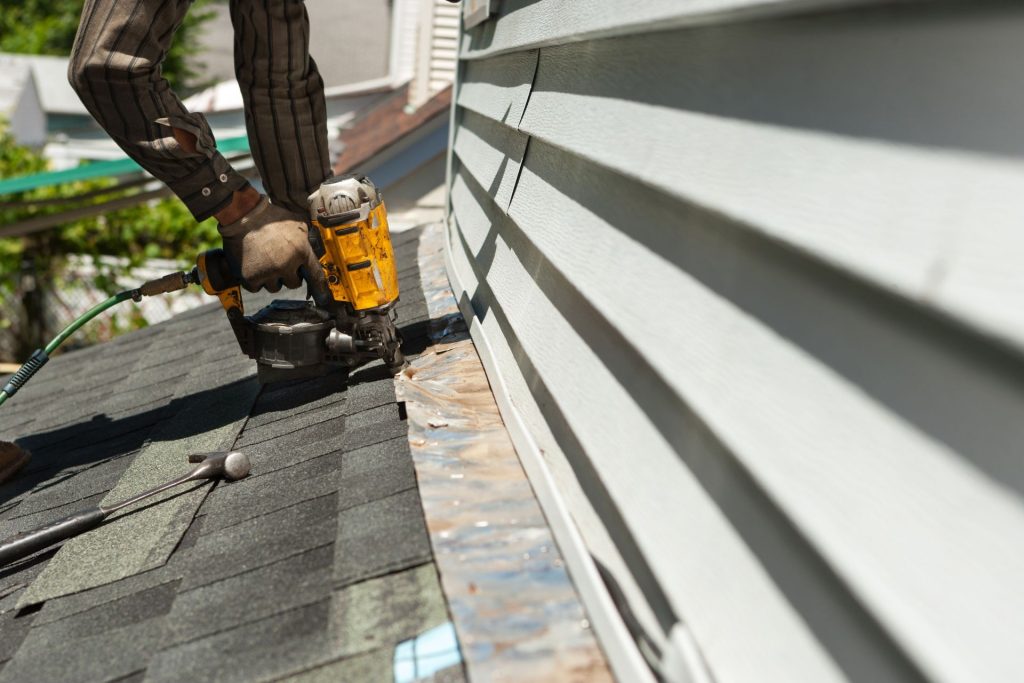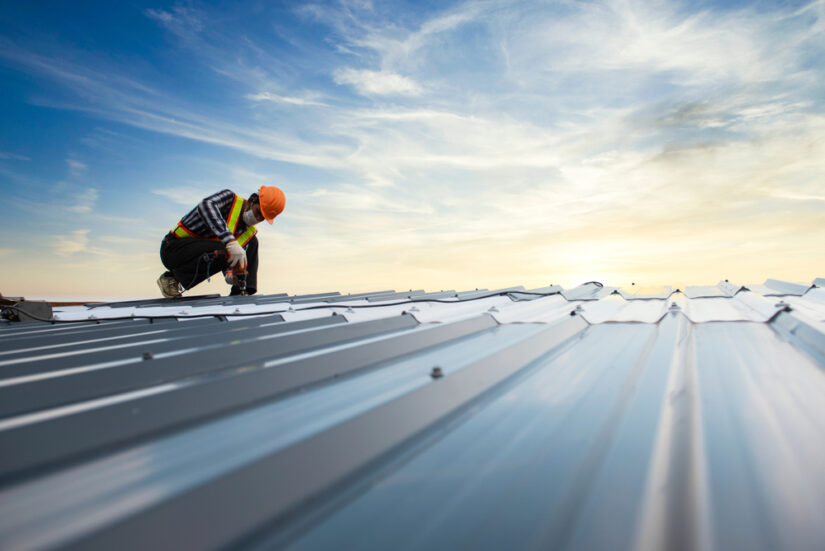Exactly How to Identify Typical Roof Covering Problems and Their Solutions
When it comes to maintaining your roof, acknowledging typical issues early can save you time and money. You may discover indications like water spots, missing roof shingles, or even moss growth.
Signs of Roofing System Leaks and Exactly How to Repair Them
A leaky roof covering can transform your home into a headache if not addressed without delay. If you see peeling off paint or mold growth, it's an indicator that dampness is entraped.
To deal with these problems, start by situating the source of the leak. Examine your attic for indicators of wetness or water entry. You can seal tiny gaps with roof covering cement or caulk as soon as you determine the problem area. For even more considerable damages, you may require to replace roof shingles or even fix flashing. If you're not sure, always assure safety first-- make use of a durable ladder and take into consideration employing a professional. Addressing leakages promptly can help you avoid pricey repairs down the line and maintain your home safe and completely dry.
Determining Missing or Damaged Tiles
When checking your roof covering, look for any kind of missing or damaged roof shingles that could cause larger issues. An aesthetic examination can expose indicators of water damage, which may indicate that it's time to repair or change those tiles. Addressing these concerns early can conserve you money and time over time.
Visual Assessment Methods
To properly identify missing or damaged roof shingles, beginning by conducting an extensive visual evaluation of your roof covering. Grab a set of binoculars for a more detailed look, or utilize a ladder if you're comfy. Look for any type of tiles that are crinkled, fractured, or totally missing. Pay special attention to locations around chimneys, vents, and valleys, as these places are vulnerable to damages. Try to find granules in your rain gutters or on the ground, which indicates wear. That can indicate a trouble if you discover any staining or unequal surfaces. Don't forget to examine the edges of your roof covering; broken or loose tiles right here can lead to bigger problems. Routine inspections can assist keep your roof covering's honesty.
Indications of Water Damages
While inspecting your roof covering for missing out on or harmed roof shingles, seek indicators of water damages that can indicate underlying concerns. Examine for dark touches or spots on the roof shingles, as these frequently signal wetness penetration. If you observe any type of crinkled or twisted roof shingles, they might also be endangered, enabling water to permeate through. Furthermore, inspect the sides of your roof covering and around smokeshafts for any kind of indications of rot or mold and mildew, which can hint at long term wetness direct exposure. Do not fail to remember to check your attic for water spots or damp insulation, as these can reveal leaks. Addressing these signs early can protect against more comprehensive damage and costly repairs down the line, ensuring your home continues to be protected.
Fixing or Replace Options

If you discover missing out on or harmed shingles during your roofing system examination, you'll need to decide whether to fix or change them. The most effective selection often depends upon the extent of the damage. If only a few shingles are impacted and the rest of your roofing is in good problem, a fixing could be all you require. Restore those locations, and you can prolong your roofing system's life.
A brand-new roofing can improve your home's visual allure and power performance. Constantly consider the age of your roofing system and your spending plan when making this choice.
Identifying Sagging Roof Coverings and Their Reasons
Identifying a drooping roofing system is crucial because it often indicates underlying architectural issues that call for prompt attention. Don't disregard them if you notice dips or unequal areas. Beginning by checking the roof for noticeable signs of sagging, like a bowing center or sagging eaves. These can suggest troubles with the rafters or trusses.

You must also check for indications of timber rot, which can damage the structure better. Don't wait; attending to the issue without delay can safeguard your investment and your peace of mind.
The Dangers of Moss and Algae Growth
Moss and algae growth on your roofing isn't just an eyesore; it can pose severe health and wellness risks and cause architectural damage with time. If left neglected, these microorganisms can endanger your roofing system's integrity and produce a reproduction ground for hazardous spores (roofing chesterfield mo). Let's check out exactly how to avoid and treat this problem successfully
Health And Wellness Hazards of Growth
While you may appreciate the all-natural charm of moss and algae on your roofing system, it's vital to recognize the prospective wellness dangers they pose. It's important to maintain your roof clear of these growths to maintain a healthy living setting. Do not overlook the value of a tidy roofing system!
Structural Damages Risks
If you let moss and algae grow on your roof, you can be setting the phase for major structural damage. These growths retain wetness, which can seep into your roof covering products, causing rotting and degeneration. In time, this wetness can deteriorate your roofing's architectural integrity, making it extra vulnerable to leakages and other issues. roofing chesterfield mo. You might observe sagging locations or water discolorations inside your home, indicating that the damage is already happening. Furthermore, moss and algae can raise tiles, developing voids that enable additional water invasion. Overlooking these indications not only risks your roofing system however likewise the whole framework of your home. Resolving moss and algae without delay is important to protecting your roofing system's life expectancy and guaranteeing your home remains risk-free.
Prevention and Therapy Approaches
Neglecting moss and algae can cause considerable issues, yet taking preventative procedures and dealing with any type of existing growth can protect your roof covering. Begin by consistently cleansing your roofing system to get rid of particles and wetness, as this creates a setting for growth. If you see moss or algae, utilize a mixture of water and bleach to delicately scrub the affected locations. For avoidance, consider mounting zinc or copper strips along the ridge of your roofing system; these steels prevent development as rain cleans over them. Additionally, assure your roofing system has correct ventilation to lower moisture buildup. By remaining proactive and attending to these concerns promptly, you can prolong your roof's life expectancy and maintain its integrity, conserving you pricey repair work down the line.
Understanding Roof Ventilation Issues
Proper roof ventilation is vital for preserving the honesty of your home, as it helps regulate temperature and wetness levels in the attic. useful site Without appropriate air flow, you may face serious issues like mold growth, timber rot, and enhanced energy costs. Inspect your roofing system for indications of bad ventilation, such as extreme warm in the attic during warm months or condensation basing on rafters.
You must additionally try to find unequal snow melting in winter, showing entraped warm. It's time to assess your air flow system if you see any of these indications. See to it you have a balanced consumption and exhaust system, enabling fresh air in and stagnant air out.
You might need to include ridge vents, soffit vents, or gable vents to enhance airflow. Normal upkeep and surveillance can stop costly repairs down the line, so do not forget this essential facet of your roofing system.

How to Spot Roof Flashing Problems
Maintaining excellent air flow is just one part of a well-functioning roof; roof covering blinking plays a crucial function in maintaining your home risk-free from water damage. To detect blinking issues, start by inspecting the locations where various roofing system areas satisfy, like vents, valleys, and chimneys. Search for any noticeable spaces, rust, or peeling off paint, which can indicate damage. Look for cracks in the caulk or sealer that may permit water to leak through.
Likewise, examine the flashing for any indications official statement of flexing or misalignment; these problems can compromise its efficiency. After heavy rainfalls, watch for water spots on your ceilings or wall surfaces, as this may signify flashing failure. It's essential to address them quickly to protect against costly damage if you discover any of these indications. Consistently examine your flashing to ensure it remains in excellent problem and executing its crucial function.
The Importance of Regular Roofing System Assessments
While it's simple to ignore, normal roof covering examinations are critical for preserving the honesty of your home. By setting up these assessments, you can capture prospective problems before they intensify right into pricey repair services. Assessors will recognize issues like missing shingles, leakages, or put on around blinking that you could not observe from the ground.
You'll additionally benefit from peace of mind, recognizing your roofing is in good form. Besides, your roof shields every little thing below it, from your family to your belongings. Normal assessments can extend your roofing's lifespan and boost its performance, conserving you money in the lengthy run.
Make it a habit to examine your roof a minimum of twice a year and after considerable weather occasions. Staying positive concerning roofing system upkeep assurances you resolve minor concerns before they develop into major migraines. So, do not wait until it's as well late-- schedule your roofing system examination today!
Regularly Asked Questions
How Usually Should I Schedule Professional Roofing System Assessments?
You need to set up specialist roofing inspections a minimum of annually. Nonetheless, after extreme weather occasions, it's smart to have an examination faster. Normal checks assist capture possible concerns prior to they escalate into costly repairs.
Can I Repair My Roof covering Myself, or Should I Employ a Professional?
You can attempt roofing system repair work yourself if you're positive and have the right tools, but hiring a contractor guarantees professional quality and safety and security. Consider your abilities and the job's complexity before choosing.
What Are the Signs I Required a New Roof Covering?
You'll recognize you require a new roofing system when you spot substantial leakages, missing shingles, extensive granule loss, or drooping locations. If your roofing system's age exceeds two decades, it's time to contemplate substitute options.
Just How Much Does Roofing Repair Typically Price?
Roofing repair work prices typically vary from $300 to $1,500, relying on the damages and materials required. You'll wish to get multiple quotes to guarantee you're making the most effective decision for your spending plan.
What Products Are Finest for Roofing in My Climate?
You ought to take into consideration materials like asphalt tiles for moderate climates, metal for resilience, and clay floor tiles in hot regions. roofing chesterfield mo. Each option has one-of-a-kind benefits, so believe concerning your climate's particular demands and your home's style
When checking your roofing, look for any missing or harmed shingles that might lead to larger problems.To successfully recognize missing out on or harmed shingles, begin by performing a complete aesthetic evaluation of your roof.While examining your roofing system for missing out on or harmed tiles, look for indicators of water damages that can indicate underlying issues.If you discover missing or damaged shingles during your roofing system evaluation, you'll need to make a decision whether to fix find more or change them.Keeping good ventilation is just one component of a well-functioning roof system; roofing blinking plays a crucial function in keeping your home risk-free from water damages.